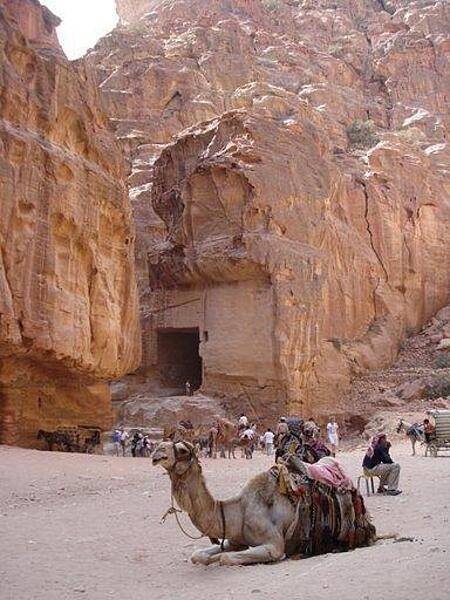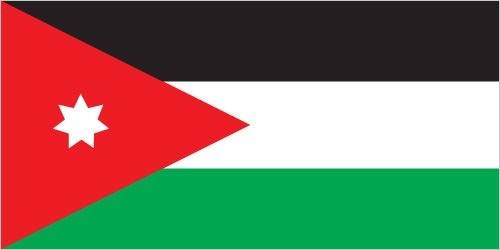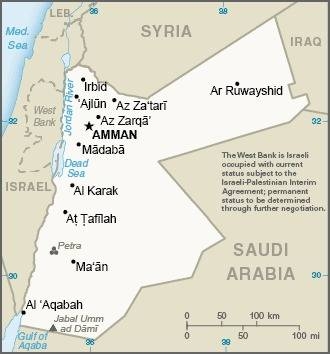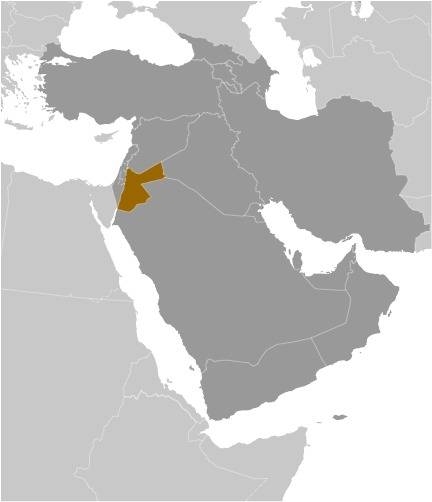Introduction
Background
Following World War I and the dissolution of the Ottoman Empire, the League of Nations awarded Britain the mandate to govern much of the Middle East. Britain demarcated a semi-autonomous region of Transjordan from Palestine in 1921 and recognized ABDALLAH I from the Hashemite family as the country's first leader. The Hashemites also controlled Hijaz, or the western coastal area of modern day Saudi Arabia until 1925, when they were pushed out by Ibn SAUD and Wahhabi tribes. The country gained its independence in 1946 and thereafter became The Hashemite Kingdom of Jordan.
The country has had four kings. Jordan's long-time ruler, King HUSSEIN (1953-99), successfully navigated competing pressures from the major powers (US, USSR, and UK), various Arab states, Israel, and Palestinian militants, which led to a brief civil war in 1970 referred to as "Black September" and ended in King HUSSEIN's ouster of the militants from Jordan. Jordan's borders also have changed. In 1948, Jordan took control of the West Bank and East Jerusalem, eventually annexing those territories in 1950 and granting its new Palestinian residents Jordanian citizenship. In 1967, Jordan lost the West Bank and East Jerusalem to Israel in the Six-Day War but retained administrative claims until 1988 when King HUSSEIN permanently relinquished Jordanian claims to the West Bank in favor of the Palestinian Liberation Organization (PLO). King HUSSEIN signed a peace treaty with Israel in 1994, after Israel and the PLO signed the Oslo Accords in 1993.Jordanian kings continue to claim custodianship of the holy sites in Jerusalem by virtue of their Hashemite heritage as descendants of the Prophet Mohammad and agreements with Israel and Jerusalem-based religious and Palestinian leaders. After Israel captured East Jerusalem in the 1967 War, it authorized the Jordanian-controlled Islamic Trust, or Waqf, to continue administering affairs in the Al Haram ash Sharif/Temple Mount holy compound, and the Jordan-Israel peace treaty reaffirmed Jordan's "special role" in administering the Muslim holy shrines in Jerusalem.
King HUSSEIN died in 1999 and was succeeded by his eldest son, ABDALLAH II, who remains the current king. In 2009, King ABDALLAH II designated his son HUSSEIN as the Crown Prince. During his reign, ABDALLAH II has contended with a series of challenges, including the Arab Spring influx of refugees from neighboring states and a perennially weak economy.
Visit the Definitions and Notes page to view a description of each topic.
Geography
Location
Middle East, northwest of Saudi Arabia, between Israel (to the west) and Iraq
Geographic coordinates
31 00 N, 36 00 E
Map references
Middle East
Area - comparative
about three-quarters the size of Pennsylvania; slightly smaller than Indiana
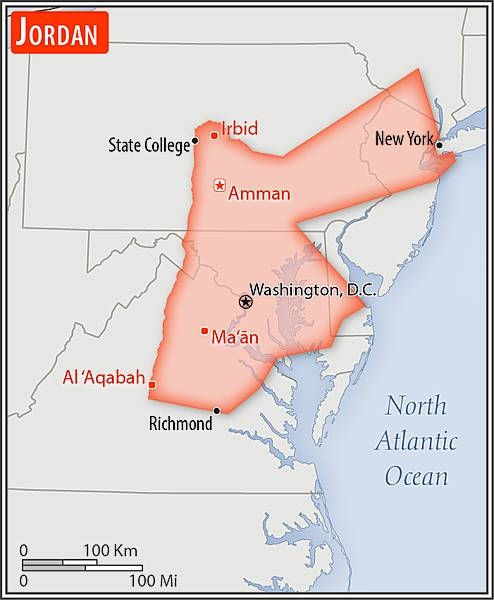
Land boundaries
total: 1,744 km
border countries (5): Iraq 179 km; Israel 307 km; Saudi Arabia 731 km; Syria 379 km; West Bank 148 km
Coastline
26 km
Maritime claims
territorial sea: 3 nm
Climate
mostly arid desert; rainy season in west (November to April)
Terrain
mostly arid desert plateau; a great north-south geological rift along the west of the country is the dominant topographical feature and includes the Jordan River Valley, the Dead Sea, and the Jordanian Highlands
Elevation
highest point: Jabal Umm ad Dami 1,854 m
lowest point: Dead Sea -431 m
mean elevation: 812 m
Natural resources
phosphates, potash, shale oil
Land use
agricultural land: 11.4% (2018 est.)
arable land: 2% (2018 est.)
permanent crops: 1% (2018 est.)
permanent pasture: 8.4% (2018 est.)
forest: 1.1% (2018 est.)
other: 87.5% (2018 est.)
Irrigated land
833 sq km (2020)
Major lakes (area sq km)
salt water lake(s): Dead Sea (shared with Israel and West Bank) - 1,020 sq km
note - endorheic hypersaline lake; 9.6 times saltier than the ocean; lake shore is 431 meters below sea level
Major watersheds (area sq km)
Indian Ocean drainage: (Persian Gulf) Tigris and Euphrates (918,044 sq km)
Major aquifers
Arabian Aquifer System
Population distribution
population heavily concentrated in the west, and particularly the northwest, in and around the capital of Amman; a sizeable, but smaller population is located in the southwest along the shore of the Gulf of Aqaba
Natural hazards
droughts; periodic earthquakes; flash floods
Geography - note
strategic location at the head of the Gulf of Aqaba and as the Arab country that shares the longest border with Israel and the occupied West Bank; the Dead Sea, the lowest point in Asia and the second saltiest body of water in the world (after Lac Assal in Djibouti), lies on Jordan's western border with Israel and the West Bank; Jordan is almost landlocked but does have a 26 km southwestern coastline with a single port, Al 'Aqabah (Aqaba)
People and Society
Population
10,998,531 (2022 est.)
note: increased estimate reflects revised assumptions about the net migration rate due to the increased flow of Syrian refugees
Nationality
noun: Jordanian(s)
adjective: Jordanian
Ethnic groups
Jordanian 69.3%, Syrian 13.3%, Palestinian 6.7%, Egyptian 6.7%, Iraqi 1.4%, other 2.6% (includes Armenian, Circassian) (2015 est.)
note: data represent population by self-identified nationality
Languages
Arabic (official), English (widely understood among upper and middle classes)
major-language sample(s):
كتاب حقائق العالم، المصدر الذي لا يمكن الاستغناء عنه للمعلومات الأساسية (Arabic)
The World Factbook, the indispensable source for basic information.
Religions
Muslim 97.1% (official; predominantly Sunni), Christian 2.1% (majority Greek Orthodox, but some Greek and Roman Catholics, Syrian Orthodox, Coptic Orthodox, Armenian Orthodox, and Protestant denominations), Buddhist 0.4%, Hindu 0.1%, Jewish <0.1%, folk <0.1%, other <0.1%, unaffiliated <0.1% (2020 est.)
Age structure
0-14 years: 33.05% (male 1,837,696/female 1,738,935)
15-24 years: 19.77% (male 1,126,567/female 1,012,812)
25-54 years: 38.39% (male 2,250,328/female 1,903,996)
55-64 years: 5.11% (male 290,633/female 262,827)
65 years and over: 3.67% (male 194,464/female 202,386) (2020 est.)
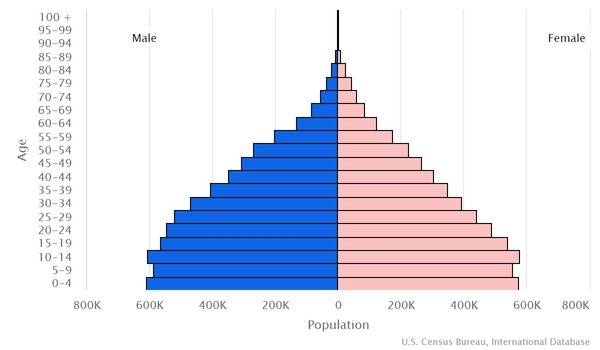
Dependency ratios
total dependency ratio: 57.1
youth dependency ratio: 51.2
elderly dependency ratio: 5.8
potential support ratio: 17.1 (2021 est.)
Median age
total: 23.5 years
male: 23.9 years
female: 22.9 years (2020 est.)
Net migration rate
-11.08 migrant(s)/1,000 population (2022 est.)
country comparison to the world: 224Population distribution
population heavily concentrated in the west, and particularly the northwest, in and around the capital of Amman; a sizeable, but smaller population is located in the southwest along the shore of the Gulf of Aqaba
Urbanization
urban population: 92% of total population (2023)
rate of urbanization: 0.98% annual rate of change (2020-25 est.)
Major urban areas - population
2.232 million AMMAN (capital) (2023)
Sex ratio
at birth: 1.06 male(s)/female
0-14 years: 1.06 male(s)/female
15-24 years: 1.08 male(s)/female
25-54 years: 1.17 male(s)/female
55-64 years: 1.12 male(s)/female
65 years and over: 0.84 male(s)/female
total population: 1.1 male(s)/female (2022 est.)
Mother's mean age at first birth
24.6 years (2017/18 est.)
note: data represents median age at first birth among women 25-49
Maternal mortality ratio
46 deaths/100,000 live births (2017 est.)
country comparison to the world: 96Infant mortality rate
total: 13.9 deaths/1,000 live births
male: 15.04 deaths/1,000 live births
female: 12.69 deaths/1,000 live births (2022 est.)
Life expectancy at birth
total population: 76.01 years
male: 74.51 years
female: 77.6 years (2022 est.)
Contraceptive prevalence rate
51.8% (2017/18)
Drinking water source
improved: urban: 99.2% of population
rural: 97.9% of population
total: 99.1% of population
unimproved: urban: 0.8% of population
rural: 2.1% of population
total: 0.9% of population (2020 est.)
Current health expenditure
7.6% of GDP (2019)
Physicians density
2.66 physicians/1,000 population (2019)
Hospital bed density
1.5 beds/1,000 population (2017)
Sanitation facility access
improved: urban: 98.8% of population
rural: 97.8% of population
total: 98.7% of population
unimproved: urban: 1.2% of population
rural: 2.2% of population
total: 1.3% of population (2020 est.)
Major infectious diseases
note: widespread ongoing transmission of a respiratory illness caused by the novel coronavirus (COVID-19) is occurring throughout Jordan; as of 9 December 2022, Jordan has reported a total of 1,746,997 cases of COVID-19 or 17,122.16 cumulative cases of COVID-19 per 100,000 population with a total of 14,122 cumulative deaths or a rate of 138.4 cumulative deaths per 100,000 population
Alcohol consumption per capita
total: 0.25 liters of pure alcohol (2019 est.)
beer: 0.06 liters of pure alcohol (2019 est.)
wine: 0 liters of pure alcohol (2019 est.)
spirits: 0.19 liters of pure alcohol (2019 est.)
other alcohols: 0 liters of pure alcohol (2019 est.)
Tobacco use
total: 34.8% (2020 est.)
male: 56.8% (2020 est.)
female: 12.8% (2020 est.)
Child marriage
women married by age 15: 1.5%
women married by age 18: 9.7%
men married by age 18: 0.1% (2018 est.)
Literacy
definition: age 15 and over can read and write
total population: 98.2%
male: 98.6%
female: 97.8% (2018)
School life expectancy (primary to tertiary education)
total: 11 years
male: 10 years
female: 11 years (2020)
Youth unemployment rate (ages 15-24)
total: 43%
male: 40.5%
female: 54.5% (2020 est.)
Environment
Environment - current issues
limited natural freshwater resources; declining water table; salinity; deforestation; overgrazing; soil erosion; desertification; biodiversity and ecosystem damage/loss
Environment - international agreements
party to: Biodiversity, Climate Change, Climate Change-Kyoto Protocol, Climate Change-Paris Agreement, Comprehensive Nuclear Test Ban, Desertification, Endangered Species, Hazardous Wastes, Law of the Sea, Marine Dumping-London Convention, Nuclear Test Ban, Ozone Layer Protection, Ship Pollution, Wetlands
signed, but not ratified: none of the selected agreements
Air pollutants
particulate matter emissions: 32.09 micrograms per cubic meter (2016 est.)
carbon dioxide emissions: 25.11 megatons (2016 est.)
methane emissions: 6.04 megatons (2020 est.)
Climate
mostly arid desert; rainy season in west (November to April)
Land use
agricultural land: 11.4% (2018 est.)
arable land: 2% (2018 est.)
permanent crops: 1% (2018 est.)
permanent pasture: 8.4% (2018 est.)
forest: 1.1% (2018 est.)
other: 87.5% (2018 est.)
Urbanization
urban population: 92% of total population (2023)
rate of urbanization: 0.98% annual rate of change (2020-25 est.)
Revenue from forest resources
forest revenues: 0.02% of GDP (2018 est.)
country comparison to the world: 142Major infectious diseases
note: widespread ongoing transmission of a respiratory illness caused by the novel coronavirus (COVID-19) is occurring throughout Jordan; as of 9 December 2022, Jordan has reported a total of 1,746,997 cases of COVID-19 or 17,122.16 cumulative cases of COVID-19 per 100,000 population with a total of 14,122 cumulative deaths or a rate of 138.4 cumulative deaths per 100,000 population
Waste and recycling
municipal solid waste generated annually: 2,529,997 tons (2013 est.)
municipal solid waste recycled annually: 177,100 tons (2014 est.)
percent of municipal solid waste recycled: 7% (2014 est.)
Major lakes (area sq km)
salt water lake(s): Dead Sea (shared with Israel and West Bank) - 1,020 sq km
note - endorheic hypersaline lake; 9.6 times saltier than the ocean; lake shore is 431 meters below sea level
Major watersheds (area sq km)
Indian Ocean drainage: (Persian Gulf) Tigris and Euphrates (918,044 sq km)
Major aquifers
Arabian Aquifer System
Total water withdrawal
municipal: 456.9 million cubic meters (2017 est.)
industrial: 32.5 million cubic meters (2017 est.)
agricultural: 554.7 million cubic meters (2017 est.)
Total renewable water resources
937 million cubic meters (2017 est.)
Government
Country name
conventional long form: Hashemite Kingdom of Jordan
conventional short form: Jordan
local long form: Al Mamlakah al Urduniyah al Hashimiyah
local short form: Al Urdun
former: Transjordan
etymology: named for the Jordan River, which makes up part of Jordan's northwest border
Government type
parliamentary constitutional monarchy
Capital
name: Amman
geographic coordinates: 31 57 N, 35 56 E
time difference: UTC+2 (7 hours ahead of Washington, DC, during Standard Time)
daylight saving time: +1hr, begins last Friday in February; ends last Friday in October
etymology: in the 13th century B.C., the Ammonites named their main city "Rabbath Ammon"; "rabbath" designated "capital," so the name meant "The Capital of [the] Ammon[ites]"; over time, the "Rabbath" came to be dropped and the city became known simply as "Ammon" and then "Amman"
Administrative divisions
12 governorates (muhafazat, singular - muhafazah); 'Ajlun, Al 'Aqabah, Al Balqa', Al Karak, Al Mafraq, Al ‘Asimah (Amman), At Tafilah, Az Zarqa', Irbid, Jarash, Ma'an, Madaba
Independence
25 May 1946 (from League of Nations mandate under British administration)
National holiday
Independence Day, 25 May (1946)
Constitution
history: previous 1928 (preindependence); latest initially adopted 28 November 1947, revised and ratified 1 January 1952
amendments: constitutional amendments require at least a two-thirds majority vote of both the Senate and the House and ratification by the king; no amendment of the constitution affecting the rights of the king and the succession to the throne is permitted during the king's reign; amended several times, last in 2016
Legal system
mixed system developed from codes instituted by the Ottoman Empire (based on French law), British common law, and Islamic law
International law organization participation
has not submitted an ICJ jurisdiction declaration; accepts ICCt jurisdiction
Citizenship
citizenship by birth: no
citizenship by descent only: the father must be a citizen of Jordan
dual citizenship recognized: yes
residency requirement for naturalization: 15 years
Suffrage
18 years of age; universal
Executive branch
chief of state: King ABDALLAH II (since 7 February 1999); Heir Apparent Crown Prince HUSSEIN (eldest son of the monarch, born on 28 June 1994)
head of government: Prime Minister Bisher AL-KHASAWNEH (since 7 October 2020)
cabinet: Cabinet appointed by the monarch prime minister in consultation with the prime minister
elections/appointments: the monarchy is hereditary; prime minister appointed by the monarch
Legislative branch
description: bicameral National Assembly or Majlis al-'Umma consists of:
Senate or the House of Notables or Majlis al-Ayan (65 seats; members appointed by the monarch to serve 4-year terms)
Chamber of Deputies or House of Representatives or Majlis al-Nuwaab (130 seats; 115 members directly elected in 23 multi-seat constituencies by open-list proportional representation vote and 15 seats for women; 12 of the 115 seats reserved for Christian, Chechen, and Circassian candidates; members serve 4-year terms)
elections: Senate - last appointments on 27 Sep 2020 (next appointments in 2024)
Chamber of Deputies - last held on 10 November 2020 (next to be held in November 2024)
election results: Senate - composition men 58, women 7, percent of women 10.8%
Chamber of Deputies - note - tribal, centrist, and pro-government candidates dominated in the 130-seat election; the Islamic Action Front, the political wing of the Muslim Brotherhood, garnered only 10 seats, down from 15 in the previous election; women, who are guaranteed 15 seats by Jordan’s legislative quota system, won 16 seats, down from 20 seats won in the previous election; composition - men 114, women 16, percent of women 12.3%; note - total National Assembly percent of women 11.8%
Judicial branch
highest court(s): Court of Cassation or Supreme Court (consists of 15 members, including the chief justice); Constitutional Court (consists of 9 members)
judge selection and term of office: Supreme Court chief justice appointed by the king; other judges nominated by the Judicial Council, an 11-member judicial policymaking body consisting of high-level judicial officials and judges, and approved by the king; judge tenure generally not limited; Constitutional Court members appointed by the king for 6-year non-renewable terms with one-third of the membership renewed every 2 years
subordinate courts: Courts of Appeal; Great Felonies Court; religious courts; military courts; juvenile courts; Land Settlement Courts; Income Tax Court; Higher Administrative Court; Customs Court; special courts including the State Security Court
Political parties and leaders
Jordan has 54 registered political parties, four of which currently have seats in the elected Chamber of Deputies - the Islamic Action Front, the Islamic Centrist Party, the United Jordanian Front Party, and the National Loyalty Party
International organization participation
ABEDA, AFESD, AMF, CAEU, CD, CICA, EBRD, FAO, G-11, G-77, IAEA, IBRD, ICAO, ICC (national committees), ICCt, ICRM, IDA, IDB, IFAD, IFC, IFRCS, ILO, IMF, IMO, IMSO, Interpol, IOC, IOM, IPU, ISO, ITSO, ITU, ITUC (NGOs), LAS, MIGA, MINUSTAH, MINUSMA, MONUSCO, NAM, NATO (partner), OIC, OPCW, OSCE (partner), PCA, UN, UNAMID, UNCTAD, UNESCO, UNHCR, UNIDO, UNISFA, UNMIL, UNMISS, UNOCI, UNRWA, UNWTO, UPU, WCO, WFTU (NGOs), WHO, WIPO, WMO, WTO
Diplomatic representation in the US
chief of mission: Ambassador Dina Khalil Tawfiq KAWAR (since 27 June 2016)
chancery: 3504 International Drive NW, Washington, DC 20008
telephone: [1] (202) 966-2664
FAX: [1] (202) 966-3110
email address and website:
hkjconsular@jordanembassyus.org
http://www.jordanembassyus.org/
Diplomatic representation from the US
chief of mission: Ambassador Henry T. WOOSTER (since 8 October 2020)
embassy: Abdoun, Al-Umawyeen St., Amman
mailing address: 6050 Amman Place, Washington DC 20521-6050
telephone: [962] (6) 590-6000
FAX: [962] (6) 592-0163
email address and website:
Amman-ACS@state.gov
https://jo.usembassy.gov/
Flag description
three equal horizontal bands of black (top), representing the Abbassid Caliphate, white, representing the Ummayyad Caliphate, and green, representing the Fatimid Caliphate; a red isosceles triangle on the hoist side, representing the Great Arab Revolt of 1916, and bearing a small white seven-pointed star symbolizing the seven verses of the opening Sura (Al-Fatiha) of the Holy Koran; the seven points on the star represent faith in One God, humanity, national spirit, humility, social justice, virtue, and aspirations; design is based on the Arab Revolt flag of World War I
National symbol(s)
eagle; national colors: black, white, green, red
National anthem
name: "As-salam al-malaki al-urdoni" (Long Live the King of Jordan)
lyrics/music: Abdul-Mone'm al-RIFAI'/Abdul-Qader al-TANEER
note: adopted 1946; the shortened version of the anthem is used most commonly, while the full version is reserved for special occasions
National heritage
total World Heritage Sites: 6 (5 cultural, 1 mixed)
selected World Heritage Site locales: Petra (c); Quseir Amra (c); Um er-Rasas (Kastrom Mefa'a) (c); Wadi Rum Protected Area (m); Baptism Site “Bethany Beyond the Jordan” (Al-Maghtas) (c); As-Salt - The Place of Tolerance and Urban Hospitality (c)
Economy
Economic overview
Jordan's economy is among the smallest in the Middle East, with insufficient supplies of water, oil, and other natural resources, underlying the government's heavy reliance on foreign assistance. Other economic challenges for the government include chronic high rates of unemployment and underemployment, budget and current account deficits, and government debt.
King ABDALLAH, during the first decade of the 2000s, implemented significant economic reforms, such as expanding foreign trade and privatizing state-owned companies that attracted foreign investment and contributed to average annual economic growth of 8% for 2004 through 2008. The global economic slowdown and regional turmoil contributed to slower growth from 2010 to 2017 - with growth averaging about 2.5% per year - and hurt export-oriented sectors, construction/real estate, and tourism. Since the onset of the civil war in Syria and resulting refugee crisis, one of Jordan’s most pressing socioeconomic challenges has been managing the influx of approximately 660,000 UN-registered refugees, more than 80% of whom live in Jordan’s urban areas. Jordan’s own official census estimated the refugee number at 1.3 million Syrians as of early 2016.
Jordan is nearly completely dependent on imported energy—mostly natural gas—and energy consistently makes up 25-30% of Jordan’s imports. To diversify its energy mix, Jordan has secured several contracts for liquefied and pipeline natural gas, developed several major renewables projects, and is currently exploring nuclear power generation and exploitation of abundant oil shale reserves. In August 2016, Jordan and the IMF agreed to a $723 million Extended Fund Facility that aims to build on the three-year, $2.1 billion IMF program that ended in August 2015 with the goal of helping Jordan correct budgetary and balance of payments imbalances.
Real GDP (purchasing power parity)
$100.16 billion (2020 est.)
$101.74 billion (2019 est.)
$99.79 billion (2018 est.)
note: data are in 2017 dollars
Real GDP growth rate
2% (2019 est.)
1.94% (2018 est.)
2.12% (2017 est.)
Real GDP per capita
$9,800 (2020 est.)
$10,100 (2019 est.)
$10,000 (2018 est.)
note: data are in 2017 dollars
GDP (official exchange rate)
$44.568 billion (2019 est.)
Inflation rate (consumer prices)
0.3% (2019 est.)
4.4% (2018 est.)
3.3% (2017 est.)
Credit ratings
Fitch rating: BB- (2019)
Moody's rating: B1 (2013)
Standard & Poors rating: B+ (2017)
note: The year refers to the year in which the current credit rating was first obtained.
GDP - composition, by sector of origin
agriculture: 4.5% (2017 est.)
industry: 28.8% (2017 est.)
services: 66.6% (2017 est.)
GDP - composition, by end use
household consumption: 80.5% (2017 est.)
government consumption: 19.8% (2017 est.)
investment in fixed capital: 22.8% (2017 est.)
investment in inventories: 0.7% (2017 est.)
exports of goods and services: 34.2% (2017 est.)
imports of goods and services: -58% (2017 est.)
Agricultural products
tomatoes, poultry, olives, milk, potatoes, cucumbers, vegetables, watermelons, green chillies/peppers, peaches/nectarines
Industries
tourism, information technology, clothing, fertilizer, potash, phosphate mining, pharmaceuticals, petroleum refining, cement, inorganic chemicals, light manufacturing
Labor force - by occupation
agriculture: 2%
industry: 20%
services: 78% (2013 est.)
Unemployment rate
19.1% (2019 est.)
18.61% (2018 est.)
note: official rate; unofficial rate is approximately 30%
Youth unemployment rate (ages 15-24)
total: 43%
male: 40.5%
female: 54.5% (2020 est.)
Population below poverty line
15.7% (2018 est.)
Gini Index coefficient - distribution of family income
33.7 (2010 est.)
36.4 (1997)
Household income or consumption by percentage share
lowest 10%: 3.4%
highest 10%: 28.7% (2010 est.)
Budget
revenues: 9.462 billion (2017 est.)
expenditures: 11.51 billion (2017 est.)
Public debt
95.9% of GDP (2017 est.)
95.1% of GDP (2016 est.)
note: data cover central government debt and include debt instruments issued (or owned) by government entities other than the treasury; the data include treasury debt held by foreign entities; the data exclude debt issued by subnational entities, as well as intragovernmental debt; intragovernmental debt consists of treasury borrowings from surpluses in the social funds, such as for retirement, medical care, and unemployment; debt instruments for the social funds are not sold at public auctions
Fiscal year
calendar year
Current account balance
-$1.222 billion (2019 est.)
-$2.964 billion (2018 est.)
Exports
$16.29 billion (2019 est.) note: data are in current year dollars
$15.09 billion (2018 est.) note: data are in current year dollars
Exports - partners
United States 21%, Saudi Arabia 13%, India 8%, Iraq 7%, United Arab Emirates 5%, China 5% (2019)
Exports - commodities
fertilizers, calcium phosphates, packaged medicines, clothing and apparel, phosphoric acid (2019)
Imports
$22.04 billion (2019 est.) note: data are in current year dollars
$22.92 billion (2018 est.) note: data are in current year dollars
Imports - partners
China 17%, Saudi Arabia 15%, United States 6%, United Arab Emirates 6%, Egypt 5%, India 5% (2019)
Imports - commodities
cars, refined petroleum, natural gas, crude petroleum, clothing and apparel (2019)
Reserves of foreign exchange and gold
$15.56 billion (31 December 2017 est.)
$15.54 billion (31 December 2016 est.)
Debt - external
$32.088 billion (2019 est.)
$29.916 billion (2018 est.)
Exchange rates
Jordanian dinars (JOD) per US dollar -
0.709 (2020 est.)
0.709 (2019 est.)
0.70925 (2018 est.)
0.71 (2014 est.)
0.71 (2013 est.)
Energy
Electricity access
electrification - total population: 100% (2020)
Electricity
installed generating capacity: 5.644 million kW (2020 est.)
consumption: 17,366,400,000 kWh (2019 est.)
exports: 98 million kWh (2019 est.)
imports: 239 million kWh (2019 est.)
transmission/distribution losses: 2.249 billion kWh (2019 est.)
Electricity generation sources
fossil fuels: 83.5% of total installed capacity (2020 est.)
nuclear: 0% of total installed capacity (2020 est.)
solar: 11.7% of total installed capacity (2020 est.)
wind: 4.6% of total installed capacity (2020 est.)
hydroelectricity: 0.2% of total installed capacity (2020 est.)
tide and wave: 0% of total installed capacity (2020 est.)
geothermal: 0% of total installed capacity (2020 est.)
biomass and waste: 0% of total installed capacity (2020 est.)
Coal
production: 0 metric tons (2020 est.)
consumption: 219,000 metric tons (2020 est.)
exports: 0 metric tons (2020 est.)
imports: 219,000 metric tons (2020 est.)
proven reserves: 0 metric tons (2019 est.)
Petroleum
total petroleum production: 0 bbl/day (2021 est.)
refined petroleum consumption: 114,800 bbl/day (2019 est.)
crude oil and lease condensate exports: 0 bbl/day (2018 est.)
crude oil and lease condensate imports: 47,400 bbl/day (2018 est.)
crude oil estimated reserves: 1 million barrels (2021 est.)
Refined petroleum products - production
67,240 bbl/day (2015 est.)
country comparison to the world: 73Natural gas
production: 115.872 million cubic meters (2019 est.)
consumption: 4,650,978,000 cubic meters (2019 est.)
exports: 375.849 million cubic meters (2019 est.)
imports: 4,910,954,000 cubic meters (2019 est.)
proven reserves: 6.031 billion cubic meters (2021 est.)
Carbon dioxide emissions
23.47 million metric tonnes of CO2 (2019 est.)
from coal and metallurgical coke: 381,000 metric tonnes of CO2 (2019 est.)
from petroleum and other liquids: 15.786 million metric tonnes of CO2 (2019 est.)
from consumed natural gas: 7.303 million metric tonnes of CO2 (2019 est.)
Energy consumption per capita
39.331 million Btu/person (2019 est.)
country comparison to the world: 108Communications
Telephones - fixed lines
total subscriptions: 391,486 (2020 est.)
subscriptions per 100 inhabitants: 4 (2020 est.)
Telephones - mobile cellular
total subscriptions: 6,987,891 (2020 est.)
subscriptions per 100 inhabitants: 68 (2020 est.)
Telecommunication systems
general assessment: Jordan’s government has focused on the use of ICT in a range of sectors, aimed at transforming the relatively small economy through the use of digital services; this policy has helped the country rise in the league tables for digital connectivity and internet readiness, and it has also attracted investment from foreign companies; during the ongoing global pandemic, the start-up sector has been further encouraged to develop solutions to combat the crisis, while other efforts have facilitated e-government services and encouraged businesses to adapt to new methods of working through their own digital transformation; these developments have been supported by the highly developed mobile sector, led by three major regional players which have near-comprehensive LTE network coverage (2022)
domestic: a 1995 telecommunications law opened all non-fixed-line services to private competition; in 2005, the monopoly over fixed-line services terminated and the entire telecommunications sector was opened to competition; currently fixed-line stands at nearly 4 per 100 persons and multiple mobile-cellular providers with subscribership over 68 per 100 persons (2020)
international: country code - 962; landing point for the FEA and Taba-Aqaba submarine cable networks providing connectivity to Europe, the Middle East, Southeast Asia and Asia; satellite earth stations - 33 (3 Intelsat, 1 Arabsat, and 29 land and maritime Inmarsat terminals (2019)
note: the COVID-19 pandemic continues to have a significant impact on production and supply chains globally; since 2020, some aspects of the telecom sector have experienced a downturn, particularly in mobile device production; progress toward 5G implementation has resumed, as well as upgrades to infrastructure; consumer spending on telecom services has increased due to the surge in demand for capacity and bandwidth; the crucial nature of telecom services as a tool for work and school from home is still evident, and the spike in this area has seen growth opportunities for development of new tools and increased services
Broadcast media
radio and TV dominated by the government-owned Jordan Radio and Television Corporation (JRTV) that operates a main network, a sports network, a film network, and a satellite channel; first independent TV broadcaster aired in 2007; international satellite TV and Israeli and Syrian TV broadcasts are available; roughly 30 radio stations with JRTV operating the main government-owned station; transmissions of multiple international radio broadcasters are available
Internet users
total: 6,768,137 (2019 est.)
percent of population: 67% (2019 est.)
Broadband - fixed subscriptions
total: 630,545 (2020 est.)
subscriptions per 100 inhabitants: 6 (2020 est.)
Transportation
National air transport system
number of registered air carriers: 4 (2020)
inventory of registered aircraft operated by air carriers: 54
annual passenger traffic on registered air carriers: 3,383,805 (2018)
annual freight traffic on registered air carriers: 175.84 million (2018) mt-km
Airports - with paved runways
total: 16
over 3,047 m: 8
2,438 to 3,047 m: 5
1,524 to 2,437 m: 2
914 to 1,523 m: 1 (2021)
Airports - with unpaved runways
total: 2
under 914 m: 2 (2021)
Heliports
1 (2021)
Pipelines
473 km gas, 49 km oil (2013)
Railways
total: 509 km (2020)
narrow gauge: 509 km (2014) 1.050-m gauge
Merchant marine
total: 35
by type: general cargo 6, oil tanker 1, other 28 (2021)
Ports and terminals
major seaport(s): Al 'Aqabah
Military and Security
Military and security forces
Jordanian Armed Forces (JAF): Royal Jordanian Army (includes Special Operations Forces, Border Guards, Royal Guard), Royal Jordanian Air Force, Royal Jordanian Coast Guard; Ministry of Interior: Public Security Directorate (includes national police, the Gendarmerie, and the Civil Defense Directorate) (2022)
note: the armed forces report administratively to the minister of defense and have a support role for internal security; the prime minister serves as defense minister, but there is no separate ministry of defense
Military expenditures
5% of GDP (2021 est.)
5% of GDP (2020 est.)
5.6% of GDP (2019 est.) (approximately $5.18 billion)
5.6% of GDP (2018 est.) (approximately $5.14 billion)
5.7% of GDP (2017 est.) (approximately $5.18 billion)
Military and security service personnel strengths
approximately 94,500 active duty armed forces personnel (80,000 Army; 14,000 Air Force; 500 Coast Guard); approximately 15,000 Gendarmerie Forces (2022)
Military equipment inventories and acquisitions
the JAF inventory is comprised of a wide mix of imported equipment from Europe, some Gulf States, Russia, and the US; since 2010, the Netherlands and the US have been the leading suppliers (2022)
Military service age and obligation
17 years of age for voluntary military service for men (women can volunteer to serve in noncombat military positions in the Royal Jordanian Arab Army Women's Corps and RJAF); initial service term 2 years, with option to reenlist for up to 18 years; conscription was abolished in 1991, but in 2020 Jordan announced the reinstatement of compulsory military service for jobless men aged between 25 and 29 with 12 months of service, made up of 3 months of military training and 9 months of professional and technical training; in 2019, Jordan announced a voluntary 4-month National Military Service program for men and women aged between 18-25 years who have been unemployed for at least 6 months; service would include 1 month for military training with the remaining 3 months dedicated to vocational training in the sectors of construction and tourism (2022)
note: most women serve in the medical service; outside the medical service, women comprised about 1.5% of the military as of 2019
Military deployments
330 Mali (MINUSMA) (May 2022)
Military - note
the Jordanian military traces its origins back to the Arab Legion, which was formed under the British protectorate of Transjordan in the 1920s
due largely to its proximity to regional conflicts in Iraq and Syria, the presence of major terrorist organizations in both of those countries, and the Israeli-Palestinian conflict, the highest priorities of Jordan’s military and security services in 2022 included securing its borders and the potential for domestic terrorist attacks; the terrorist group Hizballah and Iranian-backed militia forces were operating in southwestern Syria near Jordan’s border while fighters from the Islamic State of Iraq and ash-Sham (ISIS) terrorist group continued operating in both Iraq and Syria; ISIS fighters included Jordanian nationals, some of whom have returned to Jordan; meanwhile, individuals and groups sympathetic to Palestine have planned and conducted terrorist attacks in Jordan
Jordan has Major Non-NATO Ally (MNNA) status with the US; MNNA is a designation under US law that provides foreign partners with certain benefits in the areas of defense trade and security cooperation; while MNNA status provides military and economic privileges, it does not entail any security commitments
Jordan signed a peace treaty with Israel in 1994 (2022)
Terrorism
Terrorist group(s)
Islamic State of Iraq and ash-Sham (ISIS)
note: details about the history, aims, leadership, organization, areas of operation, tactics, targets, weapons, size, and sources of support of the group(s) appear(s) in Appendix-T
Transnational Issues
Disputes - international
Jordan-Iraq: the two countries signed a border agreement in 1984; Jordan has ratified the treaty, but it has not been confirmed that Iraq has ratified it; as of 2010, the agreement had not been registered with the UN
Jordan-Israel: none identified
Jordan-Saudi Arabia: Jordan and Saudi Arabia signed an agreement to demarcate their maritime borders in 2007
Jordan-Syria: the two countries signed an agreement in 2005 to settle the border dispute based on a 1931 demarcation accord; the two countries began demarcation in 2006
Jordan-West Bank: none identified
Refugees and internally displaced persons
refugees (country of origin): 2,307,011 (Palestinian refugees) (2020); 66,665 (Iraq), 12,866 (Yemen), 6,013 Sudan (2021); 669,483 (Syria) (2022)
stateless persons: 63 (mid-year 2021)
Illicit drugs
primarily a transshipment country for amphetamine tablets originating in Lebanon and Syria and destined for Saudi Arabia, Israel, and Gulf countries; the government is increasingly concerned about domestic consumption of illicit drugs
